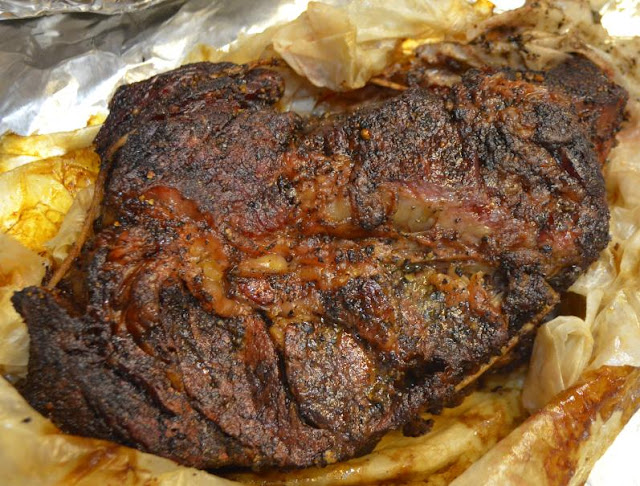 |
| Barbecued Chuck Roast Rubbed with Salt & Pepper and Wrapped with Butcher Paper During the Cook. |
 |
| The Chuck Roast on the Left was Wrapped in Butcher Paper During the Cook. The Roast on the Right was Wrapped in Foil. Notice the Difference in the Bark. |
If you want to give butcher paper a try, here are some tips.
You can find butcher paper at places like Costco, Restaurant Depot, and even several office supply stores. If you can't find it in a local store, you can also find it online. Another option is to inquire at your local butcher shop or grocery store butcher to see if they will sell you a small quantity from their stock.
 |
| Barbecued Chuck Roast Wrapped in Butcher Paper. |
Butcher paper comes in several widths. The 24" or 30" widths are best because it's easier to wrap a large cut of meat like a brisket or a long rack of ribs with the wider paper. But, if all you can find is the 18" stuff, you can make it work using a little more paper.
 |
| Butcher Paper Balled up Waiting to be Flattened Back Out and used to Wrap Barbecue. |
Butcher paper is a relatively thick paper and can be hard to work with when wrapping barbecue. A way to make the paper more pliable and easier to work with is to cut the size sheet of paper you need from the roll and ball it up then flatten it out again. Do that several times until the paper feels more pliable. I also like to put a light coat of spray oil on it before balling it up or even soaking it with water and wringing out the excess.
Another thing you want to do when wrapping barbecue with butcher paper is to make sure your last wrap around the meat is on the bottom. This will ensure that the weight of the meat will keep the paper in place while cooking.
Here is a great recipe for barbecue chuck roast using butcher paper.
Start with a 2.5 to 3 pound chuck roast. Season it with salt and pepper. Fire up your smoker/grill to a cooking temperature of about 300 degrees using indirect heat. A little oak or hickory works great for smoke.
Put the seasoned chuck roast in the smoker/grill and cook for about 2 hours. After 2 hours of cooking, remove the chuck roast from the cooker and wrap it in butcher paper. Put it back in the cooker and let it cook for about another 2 hours. You will know when it's done when an ice pick or thermometer probe slides into the meat with little resistance. The internal temperature of the meat will be around 208 - 210 degrees. But, go by the tenderness of the meat rather than the internal temperature. Once the meat has reached the proper level of tenderness, remove it from the cooker and let it rest for 30 minutes to an hour while still wrapped.
After the rest, pull the chuck roast into sections, scrape off the silver skin and excess fat, slice it against the grain and serve. One last step I like to take with chuck roast is to chop it too. It's delicious served as barbecue beef sandwiches with sauce and slaw, made into taco meat, served with eggs for breakfast, and even used in chili.
 |
| Barbecue Chuck Roast Sliced & Chopped |
For more barbecue secrets CLICK HERE.







